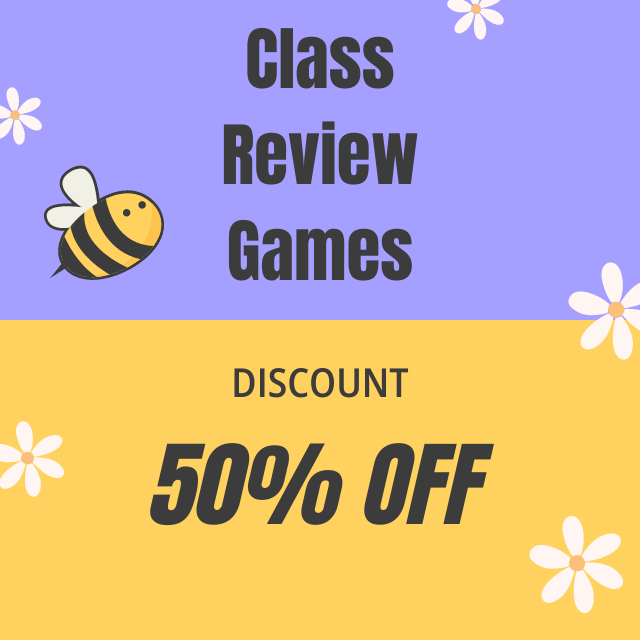Online learning can be fun, even in bigger groups. This article will find 5 fun and easy virtual classroom games and activities to boost your students’ motivation and bring joy into online classrooms. Teachers know that bringing games into the classroom boosts student engagement in a virtual learning environment.
Finding a game that allows the teacher to integrate content into the virtual classroom can be challenging. Teachers can easily transfer several popular and fun games to the virtual world, such as Jeopardy, F Taboo, Pictionary, and of course, Kahoot! Below, you will find descriptions of how to set up these virtual classroom games and activities and utilize them in your virtual classroom this year.

Our 5 Favorite Virtual Classroom Games
1. This Is Jeopardy!
As far as instructions go for setting up an interactive Jeopardy board, the easiest option is to search for a Jeopardy board template online. A simple search will yield several results, none of which differ too much in what they provide. These fun game boards are essentially Google slides that link slides to one another.
The great thing about using these templates is that duplicating the iconic Jeopardy visual is already done. Most templates are relatively simple to integrate your content into and even include instructions on how.
When playing Jeopardy in a virtual learning environment like a Bitmoji classroom, the teacher should have the game board in presentation mode and share it with the class via screen share. The most challenging thing about playing this game across a virtual class is the lack of a buzzer feature.
One option is to have a simple word for students to type into the chat box to indicate that they want to answer. Whoever’s buzzer word is sent first will get the first attempt at an answer. Should this student answer incorrectly, the next effort goes to the next in line.
This method is beneficial because it can be difficult to distinguish who is speaking on a video call. Mainly if more than one person contributes at a time; additionally, it seems as if the glitchiest feature is the sound, which could easily lead to fairness complaints. If teams are necessary, set up a simple way to determine the group in equal size, such as alphabet ranges.
2. Oooo, it’s Taboo!
Taboo is a great way to use a fun word game that challenges students’ vocabulary. The person giving clues during Taboo attempts to get their teammates to say a highlighted word, traditionally located at the top of the card. The catch is a list of five words that the clue-giver cannot use when describing the highlighted word.
Teachers can easily create a Taboo set using keywords from a unit as the highlighted words at the top of the card. Teachers can then create a list of words to avoid challenging students to be more descriptive. For example, if the keyword is Martin Luther King Jr., the words to prevent might be Dream, Civil Rights, Black, White, and Race. In this way, the challenge for students is to articulate the keyword.
When setting this game up in a virtual field, the most effective way doesn’t involve creating any cards. Teachers only need to plan the keywords and fun Taboo words. The teacher will typically send the clue giver the words on the card in a private message.
Before playing the game, the teacher should provide the class with a visual of how they will send the words. Students then know which is the keyword and which words they cannot say. Once the “card” is given to the student, they will come off of mute to convey their clues.
The teacher monitors the time and ensures the clue giver does not say any taboo words. As soon as a student guesses the correct word, the teacher must send another “card” to the clue giver. The object is for the student to take turns and to get through as many “cards” as possible.
3. Pictionary This!
Pictionary is another classic and fun classroom game and is ideal for vocabulary review. Usually, the appeal of Pictionary is its low-to-no tech requirement. This feature makes Pictionary easy to prepare while maintaining rigor and engagement. In the remote learning world, Pictionary has the same appeal. All that is needed for this fun game is a list of words for students to draw. A few platforms allow students to draw and collaborate on the same document, making their illustrations visible to everyone.
What seems to be the most intuitive platform to use is Google’s Jamboard, which is essentially an interactive whiteboard. Teachers should open a Jamboard and share the link with their class. This will put all students in the same space, allowing simple and quick transitions from one artist to the next. At the same time, the teacher should share their screen of the Jamboard so that all students can see it on Zoom. Before beginning the game, allow students to practice using the drawing, erase, and undo tools.
Like Taboo, the teacher should write the word in private chat with the artist. Students can either say their guesses out loud or type them into the chat. The last consideration for the teacher is the timer. One way to show the timer to the students is to find a timer on YouTube and split the screen shared with the class to see the Jamboard and the timer.
4. Have a Hoot with Kahoot!
Perhaps the easiest conversion from in-person to virtual learning is the fan-favorite Kahoot. Since it is technology-based, there is no instruction or setup that is different for playing virtual games. Students use their phones to enter their answers to each multiple-choice question after entering the game using a code.
Teachers share their screens on the video call to see the questions and the leaderboard after each question. Students love the familiar music that signals their chance to respond and look forward to seeing how they have jumped on the leaderboard.
This video explains how to play Kahoot on Zoom:
5. Educational Solitaire
Did you know you can learn while playing a game of online solitaire? On Solitaired.com you can play solitaire with educational decks, such as “Heroes of Space and Flight” and “Notable Women in Tech,” which combine the classic solitaire gameplay with informative content.
These thematic decks not only provide a fun learning environment but also offer students valuable insights into important historical figures and scientific achievements, making education both enjoyable and memorable.
Play Free Online Games for Fun and Learning
In addition to traditional classroom games, students can explore a variety of free online games that combine entertainment with educational value. For example, platforms offering card games like solitaire and educational decks can foster critical thinking and learning. If you’re looking for a mix of strategy and excitement, you can even play free online poker game to develop skills such as decision-making, probability analysis, and strategic planning.
Classic Card Games for Online Learning Fun
If students enjoy brain teasers and problem-solving, they might love stepping up their logical thinking with card games. A great example is when students play free Spider Solitaire card games online, which challenges their patience, pattern recognition, and decision-making skills. Whether used as a brain break or a warm-up activity, games like these keep students engaged while reinforcing valuable cognitive abilities in a fun, low-pressure way.
Virtual Games to Gain Interest and Engagement
Virtual classroom games and activities are fun and motivate the students to learn. Points that students get for winning can be in the form of extra credit or other incentives.
As long as the teacher creates the review games and activities intentionally, sets them up before the class, and explains the rules thoroughly, virtual classroom games are a surefire way to garner interest and engage with content in distance learning in a fun way.
Make sure you give students clear instructions so nobody feels excluded during the virtual classroom game.


